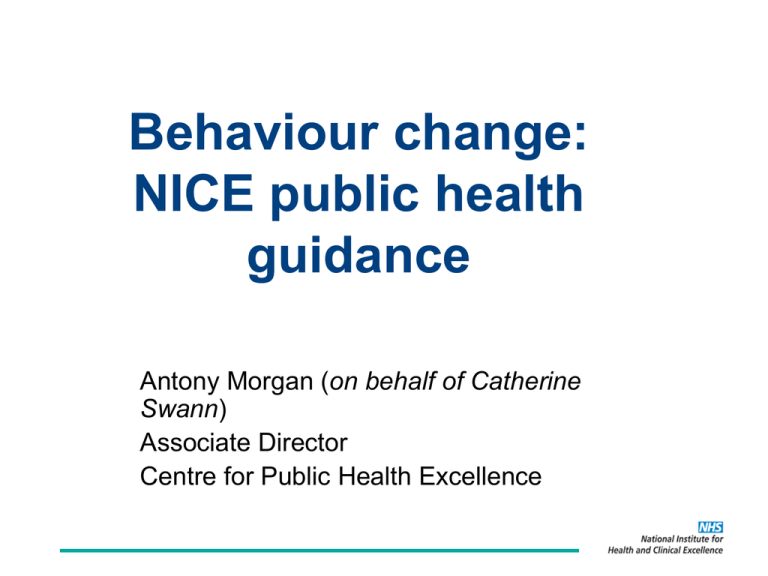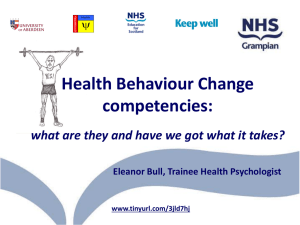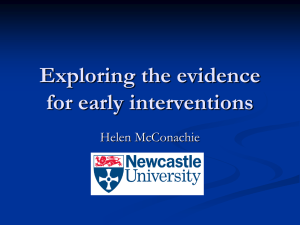Antony Morgan presentation 16 11 10
advertisement

Behaviour change: NICE public health guidance Antony Morgan (on behalf of Catherine Swann) Associate Director Centre for Public Health Excellence Overview • NICE public health guidance • Changing behaviour • Discussion Audiences for public health guidance • The NHS • Local government • The workplace • Education • The utilities • Private and voluntary sectors • Other arms of government • The public CPHE: context A Health Map, Barton and Grant 2006 concept by Whitehead and Dahlgren 1991 CPHE: conceptual model CPHE Methods 2009 and Kelly et al (Public Health 123; 1, pp e14-20) 2009 The life course approach. • • • • Critical points on life’s journey. Those critical points are like gateways. Different for different groups. The direction people go at each gateway has a profound effect on their future. • A cumulative profit and loss health account. Centre for Public Health Excellence: Produces two types of public health guidance: • Intervention guidance • Programme guidance Intervention guidance • Focus on local, clearly circumscribed actions aiming to reduce the risk of developing a disease or condition, or that help to promote or maintain good health. • Usually delivered by front line staff, targeted at certain populations, communities or individuals, e.g.: – The most effective school-based method of preventing children and young people from smoking • Just over one year to develop • Public Health Interventions Advisory Committee (PHIAC) Programme guidance • Provides a multi- agency and multi-faceted package of policies, services and interventions. • May be topic, setting or population –based and may involve changes to organisational infrastructure, e.g.: – management of long-term sickness and incapacity for work, for primary care and employers. – the nutrition of pregnant and breastfeeding mothers and children in low-income households – Prevention of cardiovascular disease at population level • Emphasis on preventive, population-based approaches • 18 - 24 Months • Programme Development Groups (PDG) 2005 referral from the Department of Health: ‘The most appropriate means of generic and specific interventions to support attitude and behaviour change at population and community levels’ Policy context: • A community of public health workers engaged day-today in processes (often) aimed at changing behaviour • The public health white paper ‘Choosing Health’ (DH, 2004): Emphasis on ‘informed choice’ and effective mechanisms for achieving change • Wanless report (2002): Signalled the need to strike an informed balance between clinical and public health intervention • Cabinet Office discussion paper, Halpern et al (2004): Sophisticated approaches to supporting behaviour change could enhance government policy, & positively influence public behaviour The need for guidance on behaviour change: • Public health activities frequently directed towards change • Public health interventions tend to be more effective when delivered from within a coherent theoretical approach • Many different models and approaches aimed at promoting or supporting knowledge, attitude and behaviour change exist • Predictive power of models is often limited, and many have been criticised for other limitations Need for guidance continued: • Health is experienced – and produced – at individual, group (community) and population levels, through complex interactions between biological, psychological and social factors. • Public health interventions can operate at any one (or more) of these levels • Key life-points or transitions (e.g. pregnancy, bereavement, entering the workforce) may optimise the potential for change, or make change particularly unlikely – and different approaches may be required Who does what? NICE – manages the overall production of the guidance (evidence, Programme Development Group, consultation, publication and dissemination, implementation) PDG - independent advisory committee of professional, practice and ‘lay’ experts, consider the evidence, have formal responsibility for developing the guidance Collaborating Centre (CC) – use established NICE methods and processes to collate and synthesise evidence Scoping -develop scope (clarification, review, consultation) -appoint PDG Development -reviews of effectiveness and cost effectiveness -economic analysis - draft guidance Validation -Consultation -Fieldwork -amendment Publication -QRG and full guidance -dissemination -implementation Key questions • What is effective? And how? • What is ineffective? And what should we disinvest in? • What is harmful or dangerous? • What is cost effective? What is the business case for public health and which interventions give the best return on investment – in the very short, short and long term Reviews of effectiveness Stirling, Cardiff, London A review of the effectiveness of interventions, approaches and models at individual, community and population level that are aimed at changing health outcomes through changing knowledge, attitudes or behaviour Review of the effectiveness of road-safety and pro-environmental interventions Resilience, coping and salutogenic approaches to maintaining and generating health: a review A review of the use of the health belief model (HBM), the theory of reasoned action (TRA), the theory of planned behaviour (TPB), and the trans-theoretical model (TTM) to study and predict health-related behaviour change The influence of social and cultural context on the effectiveness of health behaviour change interventions in relation to diet, exercise and smoking cessation Social Marketing: a review Also: Expert report: Evidence for the effect on inequalities in health of interventions designed to change behaviour Cost effectiveness review: The cost-effectiveness of behaviour change interventions designed to reduce coronary heart disease: a thorough review of existing literature Economic analysis: The cost-effectiveness of population level interventions to lower cholesterol and prevent coronary heart disease: extrapolation and modelling results on promoting healthy eating habits from Norway to the UK Despite sometimes a weak evidence base…….. • Still possible to produce recommendations that support the improvement of standards in practice through: – Mix method approaches to collecting and collating evidence – Expert opinion – Lay knowledge – Stakeholder testing and validation Community and service user perspectives • What are the important outcomes to service users and carers? • What are their views about specific interventions or approaches? • What have their experiences of accessing services and treatments been like? NICE Guidance on Effective Community Engagement http://guidance.nice.org.uk/PH9/Gu idance/pdf/English ‘What community engagement approaches and methods are effective and cost effective in improving health and reducing health inequalities’ Development: drafting the recommendations • Programme Development Group: Meet 10-12 times • Recommendations – strength and applicability of evidence – cost effectiveness – impact, including on inequalities in health – risks, benefits – implementability Recommendations - principles • Principle 1: planning • Principle 2: social context • Principle 3: education and training • Principle 4: individuals • Principle 5: communities • Principle 6: populations • Principle 7: effectiveness • Principle 8: cost effectiveness Planning • Work in partnership with individuals, communities, organisations and populations to develop plans for the target audience based on their needs and the challenges facing them • Take people’s circumstances into account (especially the socioeconomic and cultural context) • Prioritise evidence-based approaches that can be tailored and used at key times when people are likely to be open to change Social context • Identify and try to remove social, financial and environmental barriers to change • Take into account the social and environmental context • Support changes to the physical environment or the way services are delivered to help those who find it difficult (or who are not motivated) to change Education and training • Review current education and training practice in this area, and disinvest in approaches that lack supporting evidence • Ensure practitioners and volunteers have fair and equal access to training and support • Relevant national organisations should consider developing standards for these skills Working with individuals: Work with people to – • understand the consequences of their behaviour and feel positive about changing it to benefit their health • make a personal commitment to health-enhancing behaviours by setting goals and sharing these goals with others • plan change in easy steps and develop coping strategies to take account of social situations that may lead to relapse Working with communities: Invest in approaches that: • develop and maintain supportive social networks and relationships and build people’s resilience and skills • promote and support positive relationships between children and their parents or carers • help organisations and institutions to promote local participation in planning and delivering services and to participate in voluntary activities • promote access to the financial and material resources needed to help people make changes to improve their health Working with populations • Use the needs and behaviours of the target population as the basis for all interventions and programmes • Ensure population-based activities complement those delivered to individuals and communities • Ensure population-based activities are assessed in terms of the risks, costs and benefits for all target groups Effectiveness – evaluation and learning from experience • Ensure funding applications and project plans include specific provision for evaluation and monitoring • Ensure appropriate process and outcome measures are used Cost effectiveness: • Collect data for cost-effectiveness analysis, including quality of life measures • When researching or evaluating interventions and programmes estimate the cost savings involved (for instance, the cost of primary prevention versus clinical treatment) Implementing the principles: • Some aspects, such as training and evaluation, will involve extra cost • However, effective interventions should lead to cost savings within the NHS and other public sector organisations in the longer term Since publication • Lots of other organisations have become interested in behaviour change – – Thaler, RH & Sunstein, CR (2008) Nudge: improving decisions about health, wealth and happiness. Yale University Press – Institute for Government (2010) Mindspace: influencing behaviour through public policy. Cabinet Office • We are about to begin the review and revision process Experience teaches us that: • It is generally quite hard to change individuals behaviour, working one-to-one in a conscious process aimed at change • Individual approaches can work – when appropriately intense, sustained, targeted, signposted • It can be easier and cheaper to work at community or population level, and / or focus on changing the systems, environment and opportunities around people • The process of change can be slow – don’t expect miracles (although they can happen) • Intervening simultaneously at different levels, with coherent messages and reinforcing information and education with policy and environmental changes is a good idea






